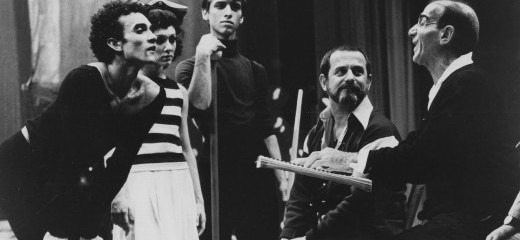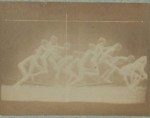
Photo: Herbert Migdoll
Ballet Simulcasts: The Joffrey Premiere
by Lynn Matluck Brooks
As the topsy-turvy world of performing-arts presenting tries to right itself in the volatile age of digital media and home entertainment, some “high-art” organizations have taken the simulcast route toward disseminating their products. Since 2007, the Metropolitan Opera has been reaching audiences across the world (but mostly in the U.S., including some NYC public schools) through satellite broadcasts of live-from-the-Met performances including such stellar productions as Julie Taymor’s direction of The Magic Flute (Mozart), the world premiere of The First Emperor (Tan Dun), and the revived Franco Zeffirelli version of La Bohème (Puccini).
Ballet too has entered this brave new world. The National Ballet of Canada beamed its Nutcracker across Canada in 2007. English companies began transmitting live performances in 2009. Europe’s CNBC has broadcast live ballet since 2010. Symphony orchestras—less visually spectacular than opera and ballet—are late-comers to the simulcast party; the Los Angeles Philharmonic, under superstar conductor Gustavo Dudamel, took the first plunge by broadcasting three of its concerts in 2010.
The distributor most visible as purveyor of the hybrid live–filmed ballet is Emerging Pictures (
http://www.emergingpictures.com/titles/). Its “Ballet in Cinema” list for 2012 features the Bolshoi in
Esmeralda,
Sleeping Beauty, Corsaire, Bright Stream, and
Raymonda, with the Royal Ballet presented also in
Sleeping Beauty as well as in
Romeo and Juliet and
La Fille Mal Gardée. Tellingly, the home page for Emerging’s simulcasts lists each ballet’s title, the company performing it, and the composer of the music, but not the choreographer. Hmmmm….
An interesting addition to the simulcast landscape is the recent documentary,
Joffrey: Mavericks of American Dance, advertised at
www.joffreymovie.com as “the first film to chronicle the legendary Joffrey Ballet from its humble beginnings touring the country in a borrowed station wagon to becoming one of the world’s most exciting and prominent ballet companies.” The statement—squishy grammar aside—sums up the trajectory of the film, written and directed by Bob Hercules and narrated by Mandy Patinkin. Its release was orchestrated into a national event, revved up through the film’s website blog. The documentary’s sold-out debut was at the Lincoln Center “Dance on Camera Film Festival” on January 27, 2012, followed the next day by Emerging Pictures’ simulcast of the film to forty communities from Massachusetts to California, including big cities like Minneapolis and small towns like Lancaster, Pennsylvania. In fact, that’s where I viewed the film—at the Ware Center of Millersville University, with a respectable-sized crowd of local dance- and culture-lovers. Appropriately
coinciding with the film’s debut was the e-book release of Sasha Anawalt’s 1998 book, The Joffrey Ballet: Robert Joffrey and the Making of an American Dance Company.
Anawalt is among the writers, dancers, administrators, and choreographers who speak their loving memories of Robert Joffrey, Gerald Arpino, and the various incarnations of the Joffrey Ballet covered in the course of the documentary. We also hear from the Joffrey’s current artistic director, Ashley Wheater, and from Kevin McKenzie, Helgi Tomasson, Lar Lubovitch, Trinette Singleton, Christian Holder, Gary Chryst, Brunilda Ruiz, Anna Kisselgoff, and others. We have the pleasure of watching such ballet legends as Léonide Massine and Kurt Jooss as they work with the Joffrey dancers on important revivals like Parade and The Green Table. The documentary makes much of the cutting-edge works that Joffrey shepherded to the stage, including his Astarte (1967), considered the first mixed-media live ballet, and the rock ballet Billboards (1993), choreographed to Prince’s music by Laura Dean, Charles Moulton, Margo Sappington, and Peter Pucci. Hercules paints a heartwarming portrait of Arpino as the company’s beloved if not always critically praised choreographer, and of the family atmosphere that shaped the early company. The film highlights Joffrey’s visionary leadership, his inspiring teaching (more could have been made of this), and his far-too-early death in 1988. The story of the company’s ups and downs—artistically and financially—helped me to understand the Joffrey’s alternating periods of high and low visibility that I recall as a young dancer growing up in the suburbs of New York.
A thrilling feature of the documentary is the dancing it captures, too briefly in most cases. We get to see excerpts of Joffrey repertory: Trinity, Viva Vivaldi, The Clowns, Round of Angels, and Olympics (Arpino), Astarte and Gamelan (Joffrey), Othello (Lubovitch), Parade (Massine), Green Table (Jooss), and Deuce Coup (Twyla Tharp). I know a film can’t go on forever, but I wished for more of the movement and a bit less of the talking heads. Still, I was thrilled to see the Chinese Conjurer’s solo from Parade presented nearly in full here; having read Massine’s description of it, I was puzzled how it was danced, but putting together the choreographer’s words and Chryst’s performance was a delight.
I read a couple of intertwined messages in the film. One, as stated, is to offer an accessible documentation of the company’s history, from Joffrey’s youthful infatuation with ballet to the company’s current incarnation in Chicago—a story it delivers well. Another point that Hercules makes is that Joffrey is really the “American” ballet company, built on American bodies (of diverse shapes, sizes, and colors), by American choreographers, with its artistic heart beating to America’s pulse. Explicit comparison is drawn between Joffrey and New York City Ballet and again between Joffrey and American Ballet Theatre, with Hercules arguing that Joffrey, far more than either American Ballet Theatre or NYCB (with its School of American Ballet) captures the laurel for really making ballet American in its origins, its personnel, and its appeal. I’m willing to consider the case.
Here’s my question: Will the emergence of ballet simulcasts draw audiences to live dance, as Joffrey did, touring the company with six dancers in a van? Or will it become painful to watch our start-up and hometown troupes once we have access to bigger-than-life stars dancing the repertories of the Joffrey, the Royal, and the Bolshoi? It’s too soon to tell, but I’m thrilled to have seen the Joffrey documentary in its premiere showing, and I’ll be there when the Ware Center broadcasts its “encore” (now, is that still a simulcast?) presentation of the Bolshoi’s Sleeping Beauty in March.
By Lynn Matluck Brooks
February 10, 2012







.png)


